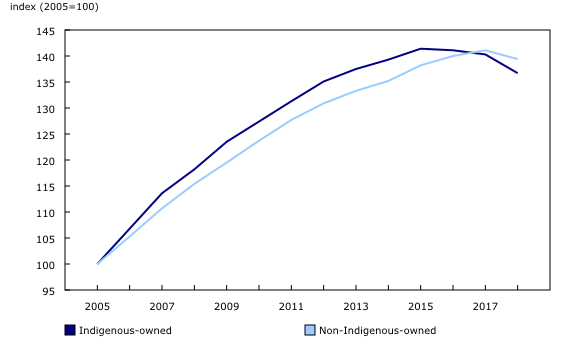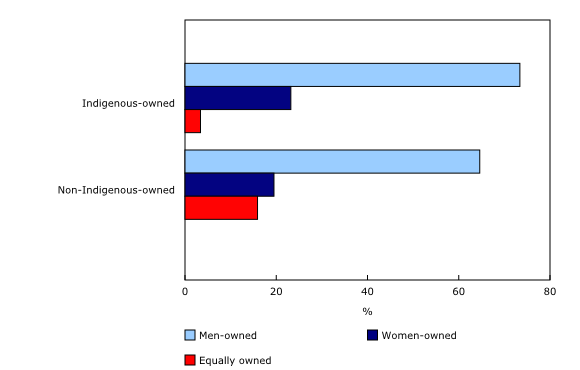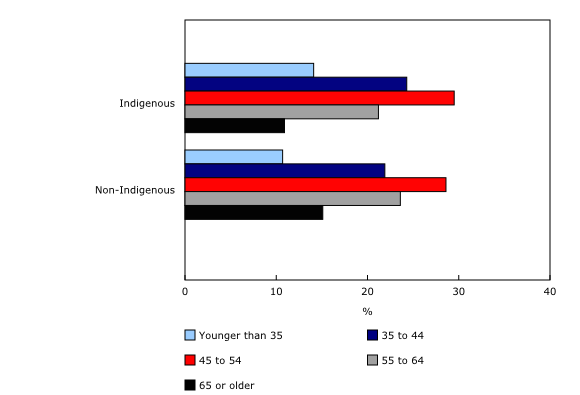Study: Identifying Indigenous business owners and Indigenous-owned businesses
Released: 2022-11-24
In 2018, there were 37,000 Indigenous-owned businesses among the 2,537,000 Canadian-controlled private corporations and unincorporated businesses in Canada for which the sex, Indigenous identity and age of the owners, as well as the province and employment size, can be defined. Similar to businesses owned by non-Indigenous individuals (66.6%), the majority of Indigenous-owned businesses (67.8%) did not have employees. Among Indigenous-owned businesses, 94.1% were controlled by First Nations people or Métis, while Inuit owned 1.6% of them. The remaining 4.3% were owned by individuals with other Indigenous identities.
These are some of the main findings of a methodology paper titled "Identifying Indigenous Business Owners and Indigenous-Owned Businesses," released today by Statistics Canada. A new linkage of the Canadian Employer–Employee Dynamics Database (2005 to 2018) with the Census of Population (2001, 2006 and 2016) and the 2011 National Household Survey made it possible to expand the content of the tables on business ownership by adding an indicator of Indigenous identity. These new linked data are the first to enable more disaggregated analysis of trends in Indigenous business ownership and potential microdata analysis. Indigenous business owners and businesses are identified using a combination of administrative databases and surveys, and imputation techniques are applied to derive the aggregate statistics.
Funded by Women and Gender Equality Canada, the tables show the number of private businesses by sex and Indigenous identity of owners, employment size, and province or region (Table 33-10-0631-01) or age of owners (Table 33-10-0632-01).
Common Output Data Repository tables
The sample of the tables released in the Common Output Data Repository is limited to Canadian-controlled private corporations and unincorporated businesses for which the sex, Indigenous identity and age of the owners, as well as the province and employment size, can be defined. Businesses in the public administration industry and unincorporated businesses without employees are excluded.
From 2005 to 2015, the number of Indigenous-owned businesses trended upward (+3.5% on average), although at a generally decreasing rate from year to year. Non-Indigenous-owned businesses also grew at a comparable rate over the same period (+3.3% on average). The number of Indigenous-owned businesses contracted in each of the subsequent years, whereas the number of non-Indigenous-owned businesses decreased only in 2018. With a generally comparable pace of growth between the two groups, the share of Indigenous-owned businesses remained stable between 1.3% and 1.4%.
More Indigenous-owned businesses in Alberta
From 2005 to 2018, Alberta was the province with the highest number of Indigenous-owned businesses (24.0% on average), followed by Ontario (20.1%) and British Columbia (17.4%). According to the 2016 and 2021 censuses of population, these provinces also had the highest number of people identifying as Indigenous. The territories (1.9%) had the lowest number of Indigenous-owned businesses, followed by Saskatchewan (6.3%) and Manitoba (6.9%). In comparison, more than half of non-Indigenous-owned businesses were located in Ontario (37.1%) and Quebec (20.8%), followed by Alberta (16.5%).
The decrease in the number of Indigenous-owned businesses was largely driven by Alberta, where it started declining in 2015. Although it is probably not the only factor, the decline may have been caused by the 2014 oil price shock, which would have affected more Indigenous-owned than non-Indigenous-owned businesses. Over the 2015-to-2018 period, the average growth in the number of businesses in Alberta was -0.3% for non-Indigenous-owned businesses and -2.4% for Indigenous-owned businesses.
The Indigenous ownership share varied across provinces and territories. Unsurprisingly, the provinces with the highest number of non-Indigenous-owned businesses were associated with the lowest Indigenous ownership share. Ontario (0.7% on average) and Quebec (1.0%) had the lowest proportions of Indigenous-owned businesses from 2005 to 2018. The territories (13.9%) were the only jurisdiction to post a double-digit Indigenous ownership share. Alberta (2.0%), the province with the highest number of Indigenous-owned businesses, had an Indigenous ownership share higher than British Columbia (1.6%) but lower than the Atlantic region (2.3%), Saskatchewan (2.6%) and Manitoba (3.6%).
The number of women-owned Indigenous businesses grows faster than that of men-owned Indigenous businesses
The majority of Indigenous-owned businesses (73.4% on average) were held by men over the 2005-to-2018 period. Women-owned and equally owned Indigenous businesses accounted for 23.2% and 3.4% of Indigenous-owned businesses, respectively. However, the distribution of Indigenous-owned businesses changed slightly over time in favour of women entrepreneurs. From 2005 to 2018, women-owned Indigenous businesses (+3.3% on average) grew more rapidly than men-owned Indigenous businesses (+2.2%). As a result, the share of women-owned Indigenous businesses increased from 22.1% in 2005 to 24.7% in 2018, whereas that of men-owned businesses dropped from 74.8% to 71.8%.
Both the shares of men-owned and women-owned businesses among Indigenous-owned businesses were higher than for non-Indigenous-owned businesses. The share of men-owned businesses among Indigenous-owned businesses was on average 10 percentage points higher than that of men-owned businesses among non-Indigenous-owned businesses (64.6%). Furthermore, Indigenous-owned businesses (23.2%) were on average proportionally more likely than non-Indigenous-owned businesses to be held by women (19.5%). The proportion of businesses equally owned by men and women was about five times higher among non-Indigenous-owned businesses than Indigenous-owned businesses.
Indigenous-owned businesses are more likely than non-Indigenous-owned businesses to be held by young entrepreneurs
From 2005 to 2018, among both Indigenous-owned and non-Indigenous-owned businesses, those owned by individuals aged 45 to 54 accounted for the highest share (29% to 30% on average). However, Indigenous-owned businesses were proportionally more likely than non-Indigenous-owned businesses to be owned by younger entrepreneurs (younger than 35; 14.1% vs. 10.7%) and less likely to be held by older entrepreneurs (65 or older; 10.9% vs. 15.1%). It is also important to note that the proportion of Indigenous-owned and non-Indigenous-owned businesses held by individuals aged 35 to 44 and 45 to 54 trended downward from 2005 to 2018 in favour of those owned by individuals aged 55 to 64 and 65 or older.
Note to readers
A business is Indigenous-owned if more than 50% of its shares are owned by Indigenous people—individuals who reported being First Nations (North American Indian), Métis or Inuk (Inuit); or who reported Registered or Treaty Indian status (as defined by the Indian Act of Canada); or who reported membership in a First Nation or Indian band.
For more information on the methodology used to identify Indigenous-owned businesses, see "Identifying Indigenous Business Owners and Indigenous-Owned Businesses."
Women-owned enterprises are defined as private businesses where the shares owned by women are greater than 50%. Men-owned enterprises are defined as private businesses where the shares owned by men are greater than 50%. Enterprises are considered equally owned if women and men each own 50% of the shares.
The Atlantic region includes the eastern Canadian provinces of Newfoundland and Labrador, Prince Edward Island, Nova Scotia, and New Brunswick.
The territories include Yukon, the Northwest Territories and Nunavut.
The Indigenous ownership rate is the number of Indigenous-owned businesses as a percentage of the total number of businesses.
The counts are not directly comparable to those from the Survey on Financing and Growth of Small and Medium Enterprises (SFGSME) because of differences in industry coverage and business size coverage. However, past comparisons have shown that estimates from the Canadian Employer–Employee Dynamics Database and the SFGSME are close when similar definitions are used (i.e., restricting the sample to those with fewer than 500 employees and to industries covered by the SFGSME). For more information, see "The Measurement of Business Ownership by Gender in the Canadian Employer–Employee Dynamics Database."
Products
The study "Identifying Indigenous Business Owners and Indigenous-Owned Businesses," part of the Analytical Studies: Methods and References series (11-633-X), is now available.
Contact information
For more information, or to enquire about the concepts, methods or data quality of this release, contact us (toll-free 1-800-263-1136; 514-283-8300; infostats@statcan.gc.ca) or Media Relations (statcan.mediahotline-ligneinfomedias.statcan@statcan.gc.ca).
- Date modified:



